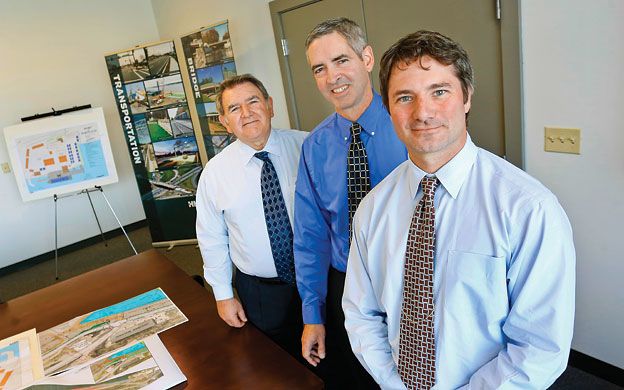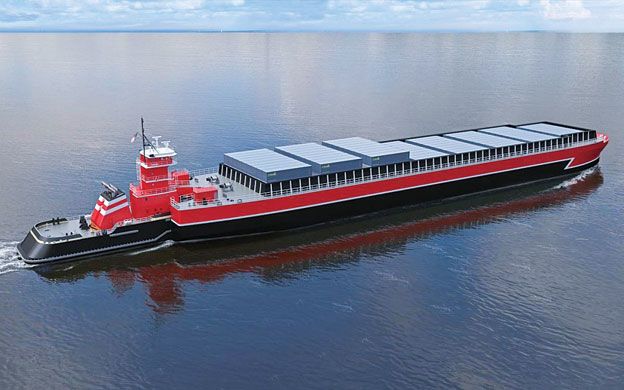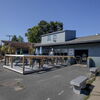Keeping the 'port' in Portland: HNTB helps revitalize city's International Marine Terminal
When Eimskip, Iceland’s largest shipping company, announced in the spring of 2013 that it was moving its U.S. port of call from Norfolk, Va., to Portland, Craig Morin admits it was an occasion for high-fives at HNTB Corp.’s Maine office in Westbrook.
“It proved our design made the port viable and attractive for a new shipping business to come here,” says Morin, a structural engineer at the employee-owned transportation infrastructure consulting company, which has approximately 3,500 employees in 60 offices and annual revenue of $1 billion.
For Morin, Eimskip’s arrival and the resulting import-export growth opportunities for Maine, illustrate how infrastructure investments supported by careful strategic analysis and planning can deliver both immediate and long-term economic benefits. He helped the Maine Port Authority and Maine Department of Transportation land a $14 million grant in 2010 under the federal Transportation Investment Generating Economic Recovery program, helping fund improvements at Maine’s three deep-water ports — Eastport, Searsport and Portland. Portland’s $5 million share paid for the upgrades at the International Marine Terminal, designed by HNTB, that set the stage for Eimskip’s arrival. The resulting cargo growth has spurred a westward expansion of the facility that upon its completion next summer will double its size and provide a direct link to Pan Am Railways via a track extension to the terminal from Cassidy Point.
“This has been a five-year process, a very collaborative effort involving the city, Maine Department of Transportation, Maine Port Authority, ourselves and all the other stakeholders,” Morin says. “We knew this wasn’t going to happen overnight.”
IMT expansion under way
HNTB, with Morin as the senior project manager, completed the site design for the IMT expansion, which includes a chassis-storage facility on 14 acres of an 18-acre parcel west of the Casco Bay Bridge. Instead of asphalt pavement, the design calls for a gravel lot of crushed stone and “separation geotextiles” to facilitate storm water drainage. Other site improvements include lighting, a security fence, a concrete loading slab for transferring containers onto or off rail cars and 4,100 feet of new rail to extend the mainline track from Cassidy Point, with a runaround track at its midpoint.
The entrance to the expanded terminal area will include a new intersection with improved sight lines at the foot of Beach Street; road widening, striping, sidewalk and truck and bike lane improvements to West Commercial Street; and a special traffic signal allowing Nova Seafood trucks to safely enter or exit its facility without the need of a flagger where Commercial Street curves just before Beach Street.
In August, MDOT awarded an $8.57 million competitive bid contract to Shaw Brothers Construction of Gorham to be the general contractor for the IMT expansion project. Morin says HNTB participates in the weekly construction meetings as an engineering resource for MDOT and Shaw Brothers to tap as the project progresses.
“A site like this will have unforeseen field conditions during construction,” he says. “We’re there to assist. It also helps us maintain a level of oversight to make sure the client is getting the product they are paying for.”
HNTB Vice President Roland Lavallee says the company’s design work on the IMT expansion draws upon the civil, structural, architectural and marine engineering design services it provided for the TIGER grant project. That work, which totaled $5 million, transformed Portland’s International Marine Terminal from a mixed ferry/cargo terminal to a modernized container freight facility with heavy-lift capabilities, 10,000 square feet of new pier space and site improvements creating an expanded storage area. The project began in October 2010 and was completed in August 2012.
“The key is to make sure the improvements you complete in Phase 1 or Phase 2 don’t preclude doing Phase 3 or 4 improvements later on,” says Lavallee, who directs the Maine office (which also serves clients in New Hampshire). “These kinds of projects typically don’t happen in one phase. It’s a collaborative effort involving a lot of stakeholders.”
At the same time, he adds, HNTB’s Maine office brings a collective depth and breadth of experience to the work it’s now doing on the IMT expansion. HNTB has been a general engineering consultant for the Maine Turnpike Authority since 1945. It provided project management, civil engineering design and construction services for the $4.5 million conversion of the New Gloucester toll plaza to open road tolling, a project completed last year. HNTB can tap engineers at its other offices to bring in expertise in rail, bridge and waterfront projects.
“Here in Maine we’ve grown from having six employees in 1996 to 35,” he says. “It’s expanded from doing almost entirely design work, to design and construction management, to transportation planning, and now it’s moved into marine engineering. We’ve grown and added expertise in order to meet our clients’ needs.”
Associate Vice President Robert Driscoll adds that each of HNTB’s projects in Maine has a designated “4 for 4” manager whose job is to ensure the project is completed on time and on budget, fully satisfies the client and achieves the highest quality standards. In the IMT expansion project, MDOT isn’t the only interested party. Other stakeholders include Phineas Sprague, whose New Yard boatyard abuts the expansion; Unitil; Pan Am Railways; Nova Seafood; city planning and economic development officials; and West End neighbors who influenced a decision to add 2-by-7-foot interpretive recessed panels to the barrier wall depicting the circa 1914 layout of the site behind the wall.
In the latter example, Driscoll says, the end result will be a barrier wall and fence that meets Homeland Security guidelines but also has an aesthetic appearance that improves on a standard Jersey barrier.
“We’re problem-solvers,” Lavallee adds.
Maximizing Portland's potential
John Henshaw, executive director of the Maine Port Authority, says the IMT expansion will enhance the turnaround that started in 2009, when the port authority took over management of the Portland terminal.
“The city didn’t have the resources to staff or upgrade the IMT on its own,” Henshaw says. “When we took it on, it was in pretty rough shape. At that time it was a mixed freight and passenger terminal. The city wanted to segregate the passenger services [at Ocean Gateway], so our first real task was to turn this into a dedicated cargo terminal that was viable.”
The IMT’s weaknesses as a cargo terminal had been documented in a 2007 report by a Fairfax, Va., transportation consulting firm hired to assess Maine’s three-port strategy, which dates to the late 1970s, and bring it into the 21st century. The Cornell Group’s primary recommendation was to develop a world-class container port at Sears Island. An estimated development cost of $194 million, combined with the recession and other factors, meant the project never materialized. But two years later the Cornell Group’s report did provide a strong foundation for the state’s successful TIGER grant application to fund port improvements in Eastport, Searsport and Portland.
Henshaw credits HNTB with making a strong business case for revitalizing Maine’s three ports. That, in turn, led to Maine receiving $14 million. It was one of only 51 recipients out of 1,380 proposals seeking American Recovery and Reinvestment Act money. Morin says HNTB then successfully competed for the opportunity to advise the port authority on how Portland’s $5 million share should be spent.
“We made a strong case for ourselves that we were the best qualified company,” Morin says, summarizing the goals of the first phase of IMT improvements as being: 1.) Increase freight tonnage for both imports and exports; 2.) Increase revenue; 3.) Improve the IMT’s marketability to new customers.
Eimskip’s 2013 arrival significantly advances those three goals. At least six other shipping companies use the Portland IMT’s improved cargo facilities. Like Eimskip, those companies will benefit when the westward expansion is completed. The expansion will provide greater storage space for containers. It will also improve efficiency by adding a mile of train track, eliminating the step of trucking freight from the IMT to the Merrill Marine Terminal on Cassidy Point Drive.
“This will remove that additional cost,” Henshaw says, adding that freight could move by rail from Cassidy Point to the Midwest and the West Coast.
Portland ranks 54th among U.S. ports for foreign trade, with 3,330.7 metric tons in 2013, according to the American Association of Ports. Through last year, it was 94th in total exports, at $67.3 million, and 47th in total imports, which totaled $2.7 billion. Henshaw expects those numbers will continue to rise, given Eimskip’s connections with ports in Eastern Canada, Greenland and Northern Europe.
“Those are very real opportunities,” Henshaw says, for Maine businesses to expand their market reach beyond the United States.
“I’m optimistic about our [three deep water] ports,” he adds, identifying Portland’s niche as the North Atlantic marketplace, Searsport’s as an “energy port” and Eastport as a biomass exporter. “There are growth opportunities for each. We’ll never complete with New York, but we can be an important niche player, with each port doing what they do best.”
Read more
Eimskip seeks boost from sports sponsorship
Eimskip boosts shipping frequency
Eimskip boosts Portland-Halifax shipping calls
Iceland officials in Maine this week












Comments